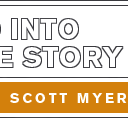Great Scene: “On the Waterfront”
“This is my church. And if you don’t think Christ is down here on the waterfront, you’ve got another thing coming.”
In a fundamental way, screenwriting is scene-writing, so the more we learn about this aspect of the craft, the better.
Today’s scene: The 1954 movie On the Waterfront, screenplay by Budd Schulberg. IMDB plot summary:
An ex-prize fighter turned longshoreman struggles to stand up to his corrupt union bosses.
A worker Kayo (Pat Henning) has been purposefully killed on the orders of Johnny Friendly (Lee J. Cobb) in a supposed dock accident. Father Barry (Karl Malden) stands over the dead body while Terry (Marlon Brando) and the other workers look on.
Some background:
- On the Waterfront (1954) is widely known to be an act of expiation on the part of Elia Kazan for naming names to HUAC during the Joseph McCarthy witch-hunts of the 1950s. What is less widely reported is that Kazan intended it as a direct attack at his former close friend Arthur Miller who had been openly critical of Kazan’s actions. Specifically, it was a direct response to Miller’s play The Crucible.
- Arthur Miller was approached by Elia Kazan to write the screenplay, and did so, but later pulled it when the FBI and studio bosses required him to make the gangsters Communists.
- The idea for the film began with an expose series written for The New York Sun by reporter Malcolm Johnson. The 24 articles won him a Pulitzer Prize and were reinforced by the 1948 murder of a New York dock hiring boss which woke America to the killings, graft and extortion that were endemic on the New York waterfront. Budd Schulberg was captivated by the subject matter, devoting years of his life to absorbing everything he could about the milieu. He became a regular fixture on the waterfront, hanging out in West Side Manhattan and Long Island bars, interviewing longshore-union leaders and getting to know the outspoken priests from St Xavier’s in Hell’s Kitchen.
The scene has obvious religious overtones: The victim a martyr; Johnny Friendly a Pontius Pilate type deciding who would live and who would die; Father Barry a lone prophet crying in the wilderness. But he speaks the truth and the workers know it. Although nothing changes immediately, the murder and Barry’s speech stick with Terry eventually causing him to act.
Two takeaways: First, if a scene calls for a monologue, consider making the character delivering a truth-teller. There is power in the truth and that can create a desire on the part of a script reader to embrace a long recitation. Second, notice how Father Barry’s speech is interrupted twice by items thrown at him, one a piece of fruit, one a can which hits him on the forehead drawing blood. The contrast between his words and those actions — that visual element — heightens the impact of the moment.
From a historical perspective, it’s interesting to parallel this story to High Noon, both attempts on the part of the filmmakers to interpret and justify their respective actions during the House on Un-American Activities Committee, both those who named names of supposed Communist sympathizers, such as Schulberg and Kazan, and those who refused and suffered as result including Carl Foreman, screenwriter of High Noon, who was blacklisted.
How about you? What’s your take on this scene? Why does it work so well? What takeaways are there for us?
To read all of the entries in the Great Scene archive, go here.
